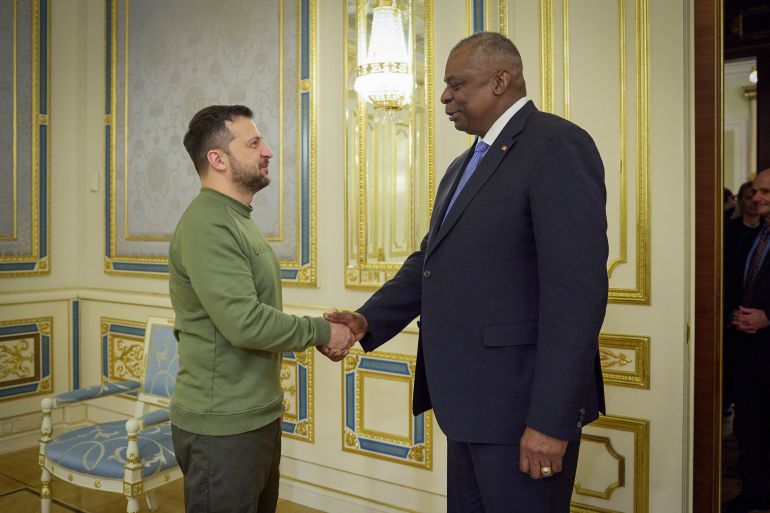US defence chief visits Kyiv, announces $100m military aid package
US will send Ukraine anti-tank weapons, air-defence equipment and an additional HIMARS system.

US Defence Secretary Lloyd Austin has made a surprise visit to Kyiv where he unveiled a new military aid package for Ukraine worth $100m.
Austin, on his first trip to Kyiv since April 2022, met with Ukrainian President Volodymyr Zelenskyy as well as Defence Minister Rustem Umerov and Commander-in-Chief General Valerii Zaluzhnyi on Monday and promised the long-term support of the United States.
Keep reading
list of 4 itemsZelenskyy sacks Ukraine’s military medical chief, urges reform of system
Qatar-UN mediation returns orphaned Ukrainian teen home after Russia ordeal
Ukraine says Russia launched new drone attacks on three regions
“The message that I bring you today, Mr President, is that the United States of America is with you. We will remain with you for the long haul,” Austin told Zelenskyy.
Austin said Ukraine’s effort to defeat Russian forces “matters to the rest of the world” and that US support would continue “for the long haul”.
The new aid package includes anti-tank weapons, air-defence interceptors and an additional High Mobility Artillery Rocket System (HIMARS).
Zelenskyy told Austin that his visit was “a very important signal” for Ukraine.
“We count on your support,” the Ukrainian president said.
Since Russia launched its full-scale invasion of Ukraine in February 2022, the US has provided more than $44bn – and allies an additional $35bn – in security support that ranges from millions of bullets to air defence systems, advanced European and US battle tanks and, finally, pledges for F-16 fighter jets.
But there are concerns that allied support is flagging amid the devastating Israel-Gaza war and a perceived lack of progress in a Ukrainian counteroffensive that began in June.
Fighting has been bogged down in the east of the country around ruined towns such as Bakhmut and Adviidka, although Ukraine has recently reported some success in the southern Kherson region, where it has established a foothold on the east bank of the Dnipro River, and in the Black Sea.
However, as the cold weather sets in, it will become more difficult for either side to make large gains due to ground conditions.
“I think they are prepared for combat in the winter,” Austin told reporters after his meetings, adding that the expectation was that Russia would be “even more aggressive”.
Last year, Moscow relentlessly attacked Ukraine’s energy infrastructure and the power grid leaving millions of Ukrainians in the cold and dark at a time when temperatures are often below zero.
Fred Kagan, a senior resident scholar at the American Enterprise Institute, said it would be a mistake to think there is time to wait.
“If we stop providing aid to Ukraine, it’s not that the stalemate continues. The aid is actually essential to preventing the Russians from beginning to manoeuvre again in ways that can allow them to defeat Ukraine,” Kagan told the Associated Press news agency. “So the cost of cutting off aid is that Russia wins and Ukraine loses and NATO loses.”
Austin’s visit comes amid increasing division over aid for Ukraine in the US Congress. Some lawmakers want to make support for Israel a priority even though US defence officials stress that Washington can support both allies simultaneously, while a small, but vocal, group of Republicans oppose sending more aid to Ukraine, saying that taxpayers’ money should be spent at home.